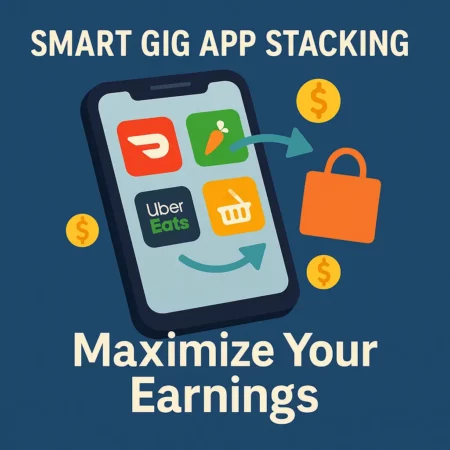The gig app that pays the most in 2025 is Instacart for full-service shoppers, with top users regularly earning $20–$30 per hour and over $200 per day in high-demand areas.
While there’s no one-size-fits-all answer, real-world data shows that some apps consistently outperform others — especially when you factor in tips, bonuses, and flexibility.
In this article, we’ll reveal the highest-paying gig apps right now, compare their earning potential, and help you decide which one is the smartest choice based on your goals, location, and lifestyle.
Quick Answer: Which Gig App Pays the Most?
If you’re looking for the single highest-paying gig app in 2025, Instacart Full-Service Shopper consistently comes out on top. Experienced users in major cities report earning $20 to $30 per hour, with some hitting $200+ in a single day during peak times, especially when batching multiple large grocery orders and receiving generous tips.
Instacart stands out because it combines high per-order payouts, frequent tipping, and the ability to cherry-pick high-paying batches — something that many other apps don’t offer. For those who can master the timing, zones, and customer communication, it’s currently one of the most profitable on-demand platforms available.
You can explore how Instacart stacks up against other major delivery platforms like Uber Eats, DoorDash, and Shipt in our full breakdown:
👉 Best Delivery Gig Apps in 2025 (Ranked)
But before you dive in, it’s important to understand that earnings vary widely based on:
Your location
The day and time you work
Bonus and peak pay opportunities
Your ability to strategically select orders
Other apps may offer strong competition depending on your skillset, schedule, and goals — which is why we’ll cover the full list of high-paying gig apps in the next section.
Highest Paying Gig Apps (Ranked & Compared)
While Instacart often tops the charts for many gig workers, it’s not the only app where serious earners are pulling in $150 to $300+ per day. The right app for you depends on your location, skill set, and whether you’re looking for flexible tasks, quick payouts, or the highest hourly rate possible.
Below is a comparison of some of the top-paying gig apps in 2025, based on real-world data, user reviews, and reported earnings across platforms like Reddit, Glassdoor, and Indeed.
Top Gig Apps by Average Earnings
| Gig App | Avg Hourly Earnings | Max Daily Potential | Best For |
|---|---|---|---|
| Instacart | $20 – $30/hr | $200+ | Grocery delivery with high tip potential |
| TaskRabbit | $25 – $75/hr (set your rate) | Varies | Skilled labor like furniture assembly, cleaning, or tech help |
| DeliverThat | $20 – $40/delivery | $150+ | Catering deliveries with pre-scheduled routes |
| Shipt | $15 – $25/hr | $150+ | Grocery delivery in areas with strong demand |
| Uber/Lyft | $15 – $30/hr | $300+ (bonuses/events) | Rideshare during peak hours and special events |
| DoorDash | $10 – $20/hr | $100 – $150 | Food delivery in busy metro areas |
| Roadie | $13 – $20/hr | $50 – $100 per gig | Long-distance or large item deliveries |
| Walmart Spark | $15 – $25/hr | $150 – $200+ | Retail delivery with potential for high tips and incentives |
Want to go deeper? We’ve ranked these based on real data and user testimonials in our complete guide to the Top 10 Highest Paying Gig Apps in 2025
Key Takeaways:
TaskRabbit leads in hourly potential — but you’ll need specific skills and availability.
DeliverThat stands out for drivers who prefer scheduled routes over waiting for random orders.
Uber and Lyft have the highest ceiling when major events or surge pricing kicks in — but daily earnings can vary drastically.
Instacart and Shipt continue to lead for on-demand shoppers who want flexibility and tipping opportunities.
DoorDash and Roadie are reliable but typically offer lower earning ceilings unless stacked with other apps.
Walmart Spark offers competitive pay, especially with incentives and tips, but experiences with tip adjustments and delivery volume can vary by region.
If you’re focused on apps with fast payouts, we’ve also created a dedicated list of gig apps that pay daily to help you stay cash-flow positive.
Why “It Depends” Isn’t Good Enough
If you’ve Googled “which gig app pays the most,” you’ve probably run into the same frustrating answer:
“It depends.”
While that’s technically true — since factors like location, time of day, and your personal hustle all play a role — it’s not a helpful answer when you’re trying to decide which app is worth your time today.
What most articles (and even Google’s AI-generated responses) miss is that patterns absolutely do emerge when you compare real-world data across platforms. Certain apps consistently pay more, offer better bonuses, or provide steadier opportunities — and that’s what gig workers actually care about.
Let’s break down the key factors that influence your income across any gig platform:
1. Location
The same app can pay $30/hour in one city and $10/hour in another. Urban areas with dense populations and high demand (like Tampa, NYC, or L.A.) almost always offer more opportunities than rural towns.
2. Time of Day & Week
Peak hours — like weekday evenings and weekend afternoons — often trigger bonuses, surge pricing, or high-tip opportunities. Apps like Uber, DoorDash, and Instacart heavily reward drivers who understand timing.
3. App Bonuses & Incentives
Weekly bonuses, referral rewards, and “earn challenges” can drastically boost your earnings. Some apps (like Walmart Spark or DeliverThat) offer extra pay for completing batches of deliveries.
4. Skill-Based vs. General Tasks
Apps like TaskRabbit or Upwork reward specialized skills. If you can hang a TV or troubleshoot tech, you might earn 2–3x more than a general delivery driver in the same amount of time.
5. Multi-App Strategy
Many of the highest earners don’t use just one app. They stack platforms — like running DoorDash, Uber Eats, and Spark simultaneously — to minimize downtime and maximize opportunity.
👉 Learn how to combine multiple platforms with our guide to stacking gig apps for maximum daily income.
So yes — “it depends” — but smart gig workers know how to stack the deck in their favor. In the next section, we’ll break down the pros and cons of on-demand vs. specialized gig apps so you can pick the best fit based on your lifestyle and goals.
Specialized vs. On-Demand Apps – Which Pays More?
One of the biggest decisions you’ll face in the gig economy is whether to go with on-demand apps like Instacart and DoorDash, or try your luck with specialized platforms like TaskRabbit or Upwork. Both offer earning potential — but in very different ways.
Let’s compare them side by side:
On-Demand Gig Apps
These apps connect you with real-time opportunities like food delivery, rideshare driving, or grocery shopping.
Examples: Instacart, Uber, Lyft, DoorDash, Walmart Spark, Shipt, DeliverThat
Pros:
Easy to start — no special skills required
Work whenever you want, as often as you want
Tips and bonuses can add up quickly
Many pay out daily or instantly
Cons:
Lower hourly ceiling unless you catch peak demand
Lots of driving = vehicle wear & tear
Income can be inconsistent day-to-day
If you want to compare top contenders in this category, we’ve got you covered with our detailed breakdown of the best delivery gig apps in 2025.
Specialized Skill-Based Apps
These platforms reward you for offering a service — anything from tech help to yard work to graphic design.
Examples: TaskRabbit, Upwork, Fiverr, Toptal, Handy
Pros:
You can set your own rates (often $25–$75/hr or more)
Less competition if you have in-demand skills
Higher ceiling for repeat business and referrals
You’re paid for your expertise, not just your time
Cons:
Requires specific skills or experience
Some platforms have intense competition (like Fiverr/Upwork)
May take longer to get your first gigs or build a client base
If this sounds like your lane, check out our full TaskRabbit review where we share real strategies to increase your earnings and stand out from the competition.
So… Which Is Better?
If you want fast money with no experience → on-demand apps are your best bet
If you have a marketable skill or trade → specialized platforms can pay far more per hour
👉 Want something in the middle? Platforms like DeliverThat or Walmart Spark offer scheduled delivery work that bridges the gap between random orders and specialized gigs — combining structure with consistent pay.
In the next section, we’ll share expert strategies to help you maximize your income on any gig app, no matter what you choose.
Tips to Maximize Your Earnings on Any Gig App
Whether you’re delivering groceries, assembling furniture, or walking dogs, how you work is just as important as where you work. The gig workers making $200–$300 a day aren’t just lucky — they’re strategic.
Here are the top ways to maximize your earnings on any gig platform:
1. Work Peak Hours (and Know When They Are)
Peak hours = higher demand = better pay.
Delivery apps: Aim for lunch (11 AM – 2 PM) and dinner (5 PM – 9 PM), especially on weekends.
Rideshare: Friday/Saturday nights, early morning airport runs, and during big events.
Shopping apps: Sundays and Mondays are grocery goldmines.
Use built-in heat maps and schedule previews (like on DoorDash and Instacart) to see when demand spikes.
2. Stack and Multi-App Strategically
Don’t just sit around waiting for orders. Gig pros run multiple apps at once.
Example combo:
Instacart for high-paying batches
DoorDash for quick fills between shops
Roadie or Spark for scheduled retail routes
Pro tip: Use one app with long downtime (like Instacart), and fill gaps with faster-paced ones (like Uber Eats).
3. Focus on High-Tip Opportunities
Apps like Instacart, Shipt, and Walmart Spark allow tipping — and tips often make up 50% or more of your income.
Maximize tips by:
Communicating clearly and politely
Providing excellent service (double-bagging, good substitutions)
Delivering fast and cleanly
You can’t ask for tips, but going the extra mile often leads to bigger ones.
4. Use Earnings Boosters and Bonuses
Most apps offer:
Weekly streak bonuses
Referral rewards
Challenges for completing X deliveries in a time window
Surge/boost zones with 1.5x–3x pay multipliers
These bonuses add up fast — and many people miss out by not checking the app’s “Promos” or “Incentives” tab regularly.
5. Track Your Expenses and Optimize
Remember: you’re technically self-employed. That means:
Track your mileage (use apps like Stride or Everlance)
Deduct gas, repairs, and supplies during tax season
Optimize your routes with apps like Gridwise, Waze, or Circuit
Your real hourly rate is earnings after expenses — the more efficient you are, the more money stays in your pocket.
Whether you’re brand new to gig work or already out there hustling, following these tips will help you squeeze the most value out of your time.
Next, let’s bring it all together with a clear, no-fluff verdict on which gig app is actually worth your time.

Final Verdict – The Best High-Paying Gig App for You
So, which gig app really pays the most?
For most people looking to earn fast, flexible money in 2025, the winner is Instacart.
It offers high per-order payouts, tipping potential, and the freedom to choose only the most profitable batches — a huge advantage if you know how to work the system.
But it’s not the only great option. Here’s a quick summary based on your goals:
| Your Goal | Best Gig App(s) |
|---|---|
| Max daily income ($200+) | Instacart, Walmart Spark, DeliverThat |
| Highest hourly rates | TaskRabbit, Toptal, Upwork |
| Fastest to get started | DoorDash, Uber Eats, Shipt |
| Best for scheduled work | DeliverThat, Roadie, Walmart Spark |
| Pays daily or instantly | DoorDash, Spark, TaskRabbit |
Ultimately, the best gig app is the one that matches your strengths, schedule, and local demand. Some users thrive on high-volume delivery apps, while others earn more by offering a single specialized service at premium rates.
If you’re ready to go deeper into this space, check out these next:
Want more ways to make money beyond delivery and freelancing? Download our free guide:
👉 50 Proven Ways to Make Money Online – No Experience, No Problem









